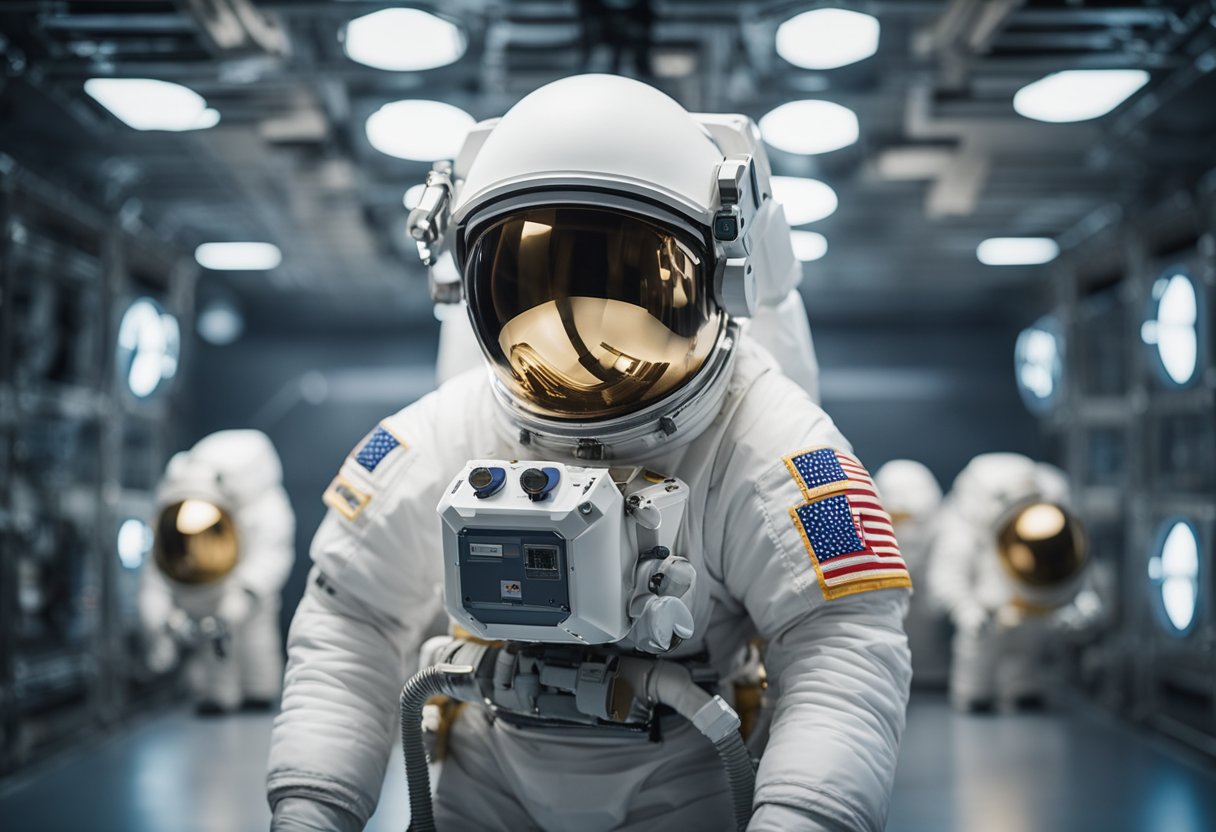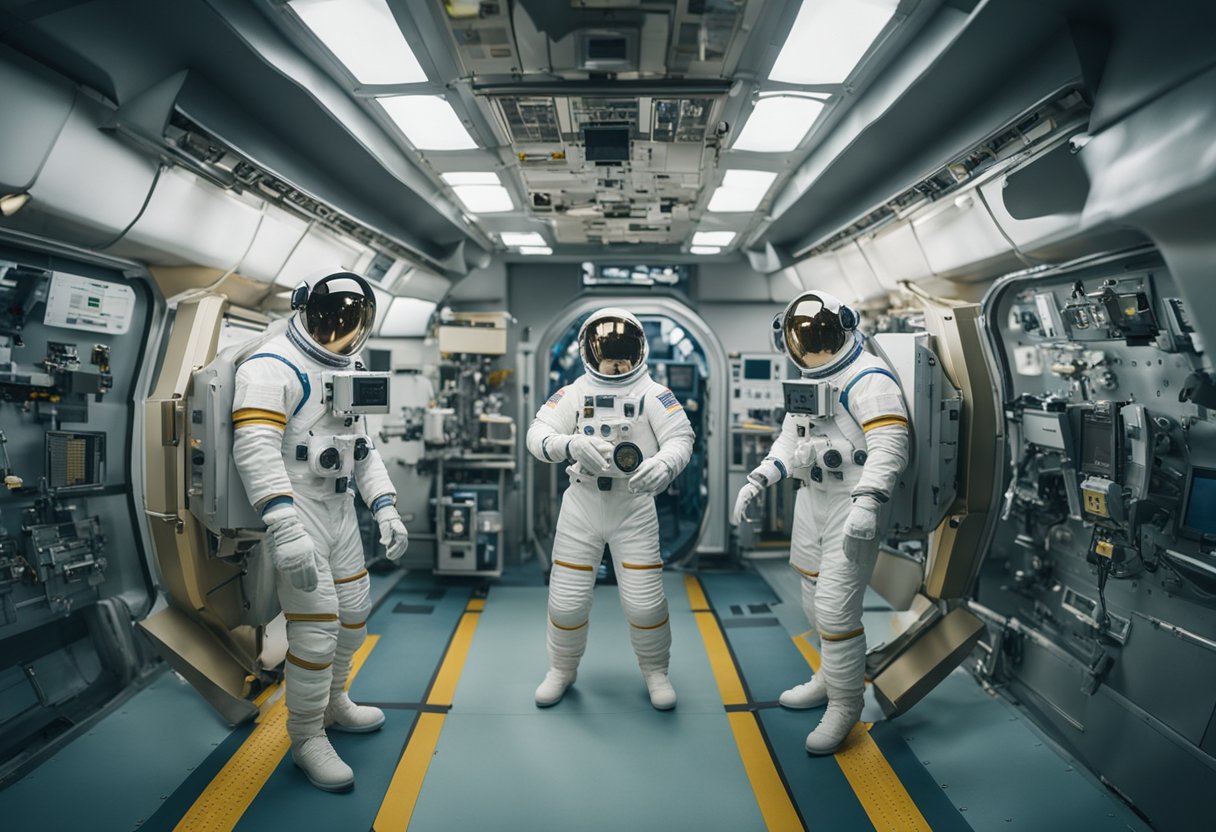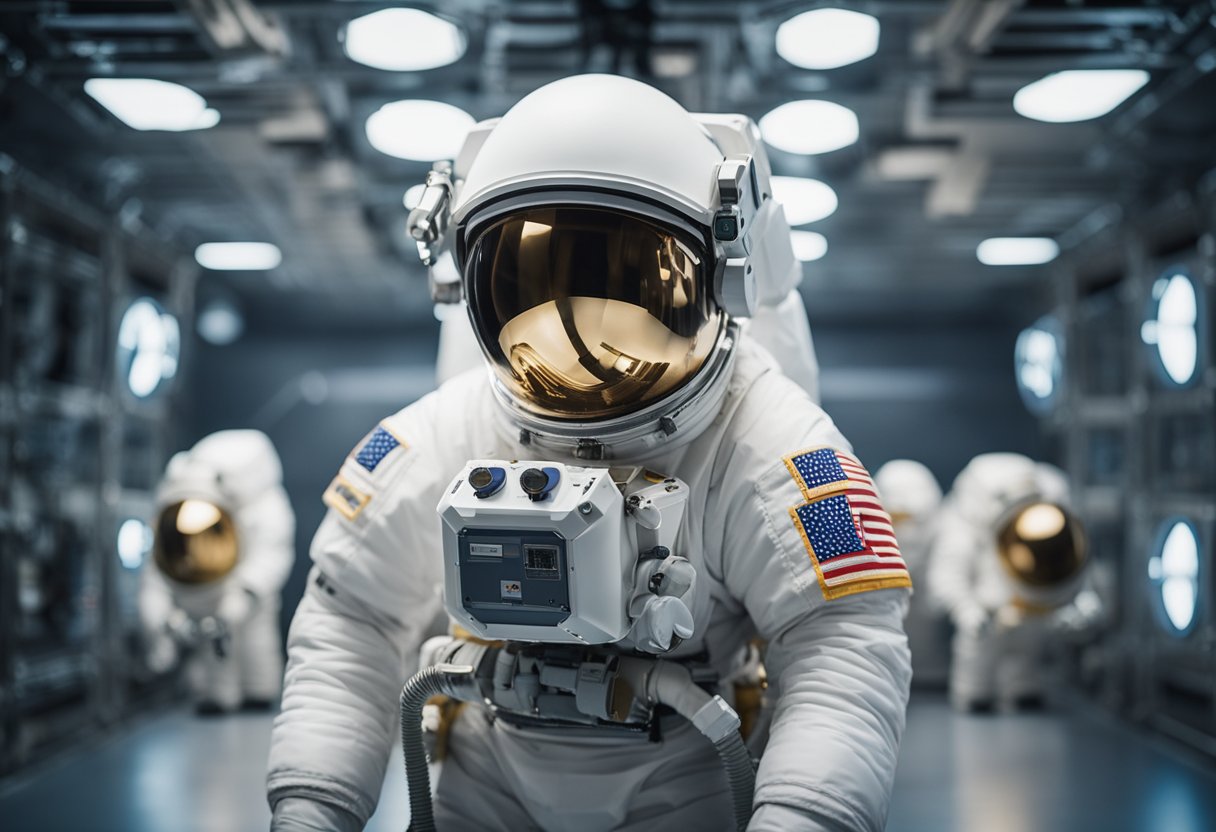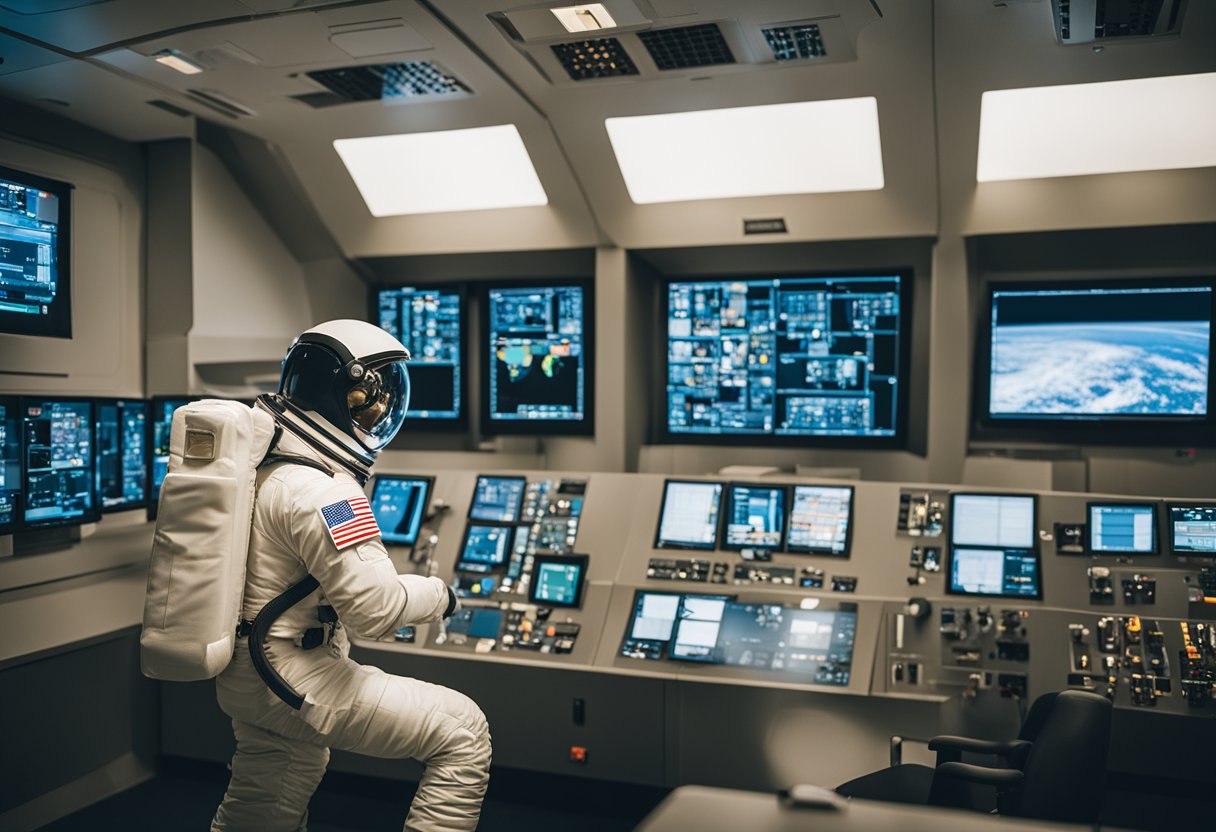
Astronaut safety is the bedrock of every space mission, from the rigours of pre-mission training to the critical moments of re-entry and post-mission recovery. Ensuring the well-being of those who venture beyond the Earth’s atmosphere is not only a priority—it’s an intricate science that evolves with every mission. Our commitment to safety is reflected in rigorous protocols, state-of-the-art support systems, and continuous research into the unique hazards of space. Key aspects like health management, psychological well-being, and protection from radiation hazards are addressed with comprehensive strategies that span the entire duration of an astronaut’s journey.

Our human-system standard guides are designed to protect the health and provide medical programmes for crew members during all phases of space flight. Ensuring the habitability of the spacecraft is essential for maintaining astronaut health and safety, and it also involves providing necessary elements for living and working in space. From the environmental control and life support systems that manage a spacecraft’s atmosphere, to carefully considered exercise and nutrition plans, every factor is methodically assessed to ensure crew members can perform their duties effectively and return home safely.
Before astronauts embark on the challenges of space travel, they undergo a rigorous selection process and comprehensive pre-mission training. This is critical not only for the success of the mission but also for ensuring the health and safety of the astronauts. Our aim is to provide an insight into how these individuals are selected and prepared.
Astronaut selection is a multifaceted screening that focuses on identifying candidates with the optimal blend of skills, performance capabilities, and health. The NASA Astronaut Medical Standards dictate that these potential astronauts meet high medical benchmarks for career candidacy and annual recertification, ensuring they can withstand the rigours of space. Our selection process examines a range of attributes, from educational backgrounds to physical fitness, ensuring each astronaut’s ability to perform specific mission tasks. The research community aids by continuing to update these standards, reflective of the latest understandings of human health under space conditions.
Once selected, astronauts partake in pre-flight education that encompasses extensive training and simulations. This regime hones their skills in a controlled environment, preparing them for unexpected scenarios they may encounter. High-fidelity simulations provide hands-on experience, bridging theoretical knowledge with practical application. Additionally, astronauts maintain a rigorous exercise routine to counteract the effects of microgravity on the body, thereby safeguarding their health throughout the mission. This preparation is pivotal to astronaut performance, ensuring each individual is mission-ready in all aspects of operation.
Our methods continue to evolve with the advancement of space exploration, and we keep a keen eye on emerging ventures like SpaceVoyageVentures.com, which is shaping the future of space tourism, presenting new areas for our protocols to expand and adapt.
Before astronauts step into the vacuum of space, they must be equipped with a sophisticated ensemble designed for safety and functionality. We’ll explore the intricate design of the spacesuit and the critical safety features of the EMU.
Spacesuits, or Extravehicular Mobility Units (EMUs), are marvels of engineering tailored to safeguard astronauts against the unforgiving vacuum of space. Each suit is a complex system that encapsulates life support and mobility features specifically designed for operations outside a spacecraft.
In the realm of spacesuit design, we witness a confluence of thermal regulation, micrometeoroid protection, and pressurisation. A spacesuit must provide a stable internal environment, allowing the astronaut to breathe, communicate, and move with a relative degree of agility. Enhanced mobility in the suit is paramount for the effective operation of instruments and manoeuvring in microgravity conditions.
Safety in an EMU takes precedence above all. The suit incorporates multiple layers for thermal protection and to ward off space debris, coupled with a life support system which maintains oxygen levels and removes carbon dioxide. Each EMU is also equipped with a Safety Tether System, which ensures astronauts remain anchored to their spacecraft or the International Space Station during spacewalks, preventing the risk of becoming adrift in space.
Moreover, the EMU includes state-of-the-art communication systems for uninterrupted contact with mission control. An advanced display and control module within the suit allow astronauts to monitor vital signs and regulate life support systems. These extensive safety features epitomise the pinnacle of operational spacesuit design and the relentless pursuit of astronaut safety.

Maintaining astronaut health is crucial during space missions, where they are subject to unique environmental stressors. Our focus is on routine health monitoring and the in-flight healthcare protocols that are essential for the well-being of crew members.
We perform regular medical assessments to ensure the ongoing health and capability of astronauts in space. These assessments are designed to:
These evaluations are critical to detecting any potential issues early, allowing for timely intervention and management.
Astronauts have access to a set of comprehensive healthcare protocols to manage medical events during their mission:
In-flight healthcare is continuously updated, integrating the latest advancements in space medicine from agencies like NASA and incorporating findings from ongoing research.
To maintain the well-being of astronauts, Environmental Control and Life Support Systems (ECLSS) are pivotal in spacecraft design. These systems ensure the provision of clean air, appropriate pressure, and regulated temperatures while efficiently managing waste.
We realise the importance of maintaining a balmy atmospheric pressure and adequate oxygen levels, which are crucial for astronauts’ respiration and overall health. The ECLSS mimics Earth’s atmosphere by regulating the spacecraft’s pressure and dissipating nitrogen appropriately to prevent decompression sickness. Likewise, the introduction of oxygen into the cabin is carefully controlled to support vital biological processes.
Command of cabin temperature is fundamental for comfort and the prevention of equipment failure. We employ thermal control systems that stabilise temperatures within ranges suitable for both crew and electronics. In terms of waste management, ECLSS is designed to convert by-products into reusable substances efficiently. Solid wastes are compacted and stored securely, while liquid wastes are treated — some technologies even allow for the recycling of urine into potable water.
Maintaining astronaut health during space missions requires meticulous planning around exercise and nutrition. These are critical to combating the effects of microgravity on the body and ensuring astronauts remain fit and healthy throughout their journey.
In the weightlessness of space, our muscles and bones are at risk of weakening without the natural resistance provided by Earth’s gravity. To counteract this, we advocate a regime of daily exercise employing specialised equipment. For instance, astronauts use the Advanced Resistive Exercise Device (ARED) on the International Space Station (ISS), which simulates lifting weights to preserve muscle strength and bone density.
Treadmills and stationary bicycles are also on board, outfitted with restraints to keep the astronaut from floating away. These aerobic exercises are essential, as they help maintain cardiovascular health. Effective countermeasures like these are necessary for both short-term missions and long-term space habitation plans—where maintaining physical health is paramount, as detailed in research on astronaut fitness and muscle strength.
In orbit, our nutritional needs are amplified, yet we have to manage with the limitations of food supply in space. Nutrients crucial for bone health, such as calcium and vitamin D, must be present in higher quantities to offset the accelerated bone loss experienced in microgravity. Likewise, maintaining adequate caloric intake is vital due to increased energy demands.
We ensure that astronauts have access to a variety of food forms, including rehydratable, heat-stabilised, and natural form foods. The challenge is not only providing a balanced diet but also ensuring the food remains palatable and safe for long durations, which is explored in a scoping review of long-term space nutrition. Moreover, the ability to tailor foods to individual nutritional requirements is becoming increasingly important for both space missions and for potential future applications within our realm, such as space tourism, as documented on platforms like SpaceVoyageVentures.com. Reducing the risk of nutrient deficiencies is a fundamental part of our sophisticated life support systems in space.
In preparation for the rigours of space, our focus on astronauts’ mental wellness is as critical as their physical health. Psychological support mechanisms are essential to sustain both individual and collective resilience.
Isolation in space can lead to significant behavioural health challenges. We recognise the importance of equipping astronauts with strategies to cope with feelings of seclusion, especially during long-duration missions where communication delays with Earth can exacerbate a sense of isolation. Our protocols incorporate regular psychological check-ins and virtual reality environments that simulate Earth-like settings to mitigate the effects of being away from home.
Maintaining high crew morale and positive interpersonal dynamics is key in the confined spaces of a spacecraft. Our training includes conflict resolution exercises and cultural sensitivity training, aimed at fostering a cohesive crew environment. Additionally, we implement stress management programmes that involve routine physical exercise and recreational activities to bolster team spirit and mental health.
By acknowledging and preparing for these psychological dimensions, we are committed to ensuring space travel remains as safe for the mind as it is for the body.
In addressing the safety of astronauts, we focus prominently on the critical issue of radiation hazards in space and the various effective protection strategies.
Cosmic radiation consists of high-energy particles that originate outside our solar system, known as galactic cosmic rays (GCRs), and from our sun, termed solar particle events (SPEs). Radiation exposure to these particles can be detrimental to the health of astronauts, leading to increased risks of cancer and other health issues. To ensure astronauts are well-informed about these risks, agencies like NASA have developed radiation protection protocols which include comprehensive education and medical monitoring. Effective measures are crucial in both the design of spacecraft and the execution of space missions.
We utilise a multi-faceted approach to radiation shielding, aiming to mitigate the risks posed by both GCRs and SPEs. Radiation protection strategies encompass the optimisation of spacecraft design—incorporating materials that provide effective shielding, and developing habitats that can withstand these cosmic hazards. In the event of increased radiation exposure, we advocate for procedural responses, such as taking refuge in specially designed storm shelters. Additionally, the use of wearable protection gear for astronauts is considered to augment these protective measures. We’re continuously exploring innovative methods to enhance astronaut safety, which are crucial for the sustainability of prolonged human presence in space.
Incorporated into these strategies is the use of technology like the RAD Radiation Assessment Detector. This tool not only acts as an alarm to prompt immediate sheltering when radiation exceeds safe levels but also records dose rates to ensure they stay within permissible exposure limits. The importance of such immediate response capabilities becomes paramount in the case of communication loss with ground control.
When orchestrating missions beyond Earth’s atmosphere, we meticulously prepare for various contingencies. This ensures astronaut safety, particularly during medical crises and potential collisions with space debris.
In space, the absence of gravity and the isolation of the spacecraft environment add complexity to medical operations. Our protocols for handling medical emergencies include comprehensive training in medical procedures for all crew members and ensuring that every mission is equipped with a well-stocked medical kit. Additionally, we adopt simulation-based training on Earth to cement these critical skills, allowing for quick and effective response to any health issues that may arise. During extravehicular activity (EVA), astronauts are prepared for potential medical issues, from minor ailments to life-threatening conditions. Remote guidance from a dedicated ground medical team supports the crew in administering emergency care.
The threat of collision with space debris necessitates robust collision avoidance measures. Our spacecraft are equipped with advanced monitoring systems to detect and track objects that could pose an impact risk. In the event of an imminent threat, we execute precise manoeuvres to alter the spacecraft’s orbit and avoid collision. Additionally, the International Space Station and similar habitats apply “Whipple shielding” to minimise damage from smaller debris pieces. Our rigorous impact management strategies are ever-evolving, incorporating new technologies and procedures to fortify astronaut safety against potential hazards.
Ensuring the safe return of astronauts from space requires meticulous preparation and adherence to safety protocols. Our focus on decompression procedures and comprehensive post-flight health monitoring is key to maintaining astronaut health.
The return journey from space involves a carefully orchestrated set of procedures to mitigate the risks of decompression sickness. As we transition from microgravity to Earth’s gravity, re-entry introduces several physiological challenges. Astronauts use a pre-breathing protocol, taking in pure oxygen to eliminate nitrogen from the body, which reduces the risk of decompression sickness, also known as ‘the bends’.
Re-entry procedures are rigidly structured. Our spacecraft are designed to withstand the intense heat generated by re-entry, and we suit-up in special pressure suits to maintain stable blood pressure. Trajectory calculations are stringently checked to ensure a safe and precise landing within designated recovery zones.
Once back on Earth, our astronauts undergo comprehensive medical examinations to assess their adaptation to Earth’s gravity. Physical rehabilitation is tailored to each astronaut, focusing on restoring strength, balance, and endurance lost in a microgravity environment.
Regular health monitoring continues for months after the mission to track any long-term changes in their health. This includes monitoring bone density, muscle condition, and organ function, ensuring a complete return to pre-flight health. Our rehabilitation programme is supported by a team of specialists in aerospace medicine, physiotherapy, and nutrition, all of whom are integral to the astronauts’ recovery.
In preparing for long-duration space missions, we acknowledge the critical importance of safeguarding astronaut health. Our focus on extensive research ties directly to the formulation of evidence-based protocols.
Long-duration space missions elevate the risk to astronauts’ health in several key areas, including cardiovascular health and bone mineral density loss. To combat these, we implement comprehensive countermeasures that are daily exercise regimens, dietary plans, and medication if necessary, all developed from research data.
Research underpins all safety measures for astronaut missions. By closely examining past mission data and integrating new findings, we continuously refine our health and safety protocols. Notably, a review highlights NASA’s preparations for long-term missions by the 2030s. Moreover, our partnerships with space tourism entities like SpaceVoyageVentures.com provide insights into the adaptation of safety protocols for commercial space travellers.
Key research contributions:
Through these efforts, we place astronaut safety at the forefront by relying on a robust evidence base that informs our long-term health strategies.

In the coming years, astronaut safety protocols are set to advance in tandem with the growing complexity of space missions. As we look toward new horizons, innovations in technology and operational strategies are at the forefront of ensuring astronaut well-being.
Spacesuit design is pivotal for astronaut protection, especially for exploration-class missions. We are advancing materials and systems to enhance suit flexibility while maintaining critical life support in the harsh conditions of deep space and planetary surfaces. Suits will likely feature improved radiation shielding and incorporate smart materials that adapt to different environmental threats automatically.
Our concept of operations for deep space endeavours demands meticulous preparation, focusing on crew well-being during long-duration travel. In-depth research on planetary surface adaptation will lead to the establishment of habitats that shield astronauts from extreme conditions. Advanced medical protocols are also underway to address the unique health challenges posed by extended spaceflight and extraterrestrial environments.

In this section, we address some of the most pertinent questions regarding astronaut safety protocols during space missions, detailing the measures and equipment that ensure the well-being of those who venture into space.
We incorporate rigorous testing of spacecraft systems and continuous monitoring to ensure astronaut safety. Before and during missions, every possible scenario is simulated and practiced to prepare for real-life situations astronauts might face.
Astronauts adhere to specific operations protocols designed to mitigate risks. These guidelines include meticulous planning of activities, strict communication procedures, and operational checklists to manage the complexity of missions.
Our astronauts undergo extensive emergency preparedness training, simulating scenarios such as fire, depressurisation, or medical events. Regular safety drills are conducted to ensure each team member can respond effectively in crisis situations.
The survival of astronauts is reliant on life-support systems, spacesuits that provide pressurization and oxygen, and secure habitats. Additionally, they have emergency supplies like food, water, and medical kits designed for zero-gravity environments.
NASA prioritises the well-being of ISS crew members by offering comprehensive healthcare, ensuring a healthy living environment, and monitoring occupational health. Physical exercise devices and scheduled activities to support mental health are also integral parts of their well-being program.
Since the dawn of space travel, advancements in personal safety equipment have been significant, ranging from enhanced spacesuit designs to improved support systems within spacecraft. These developments increase the resilience of astronauts to the harsh conditions of space travel.